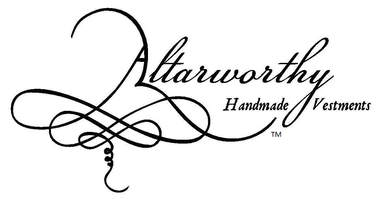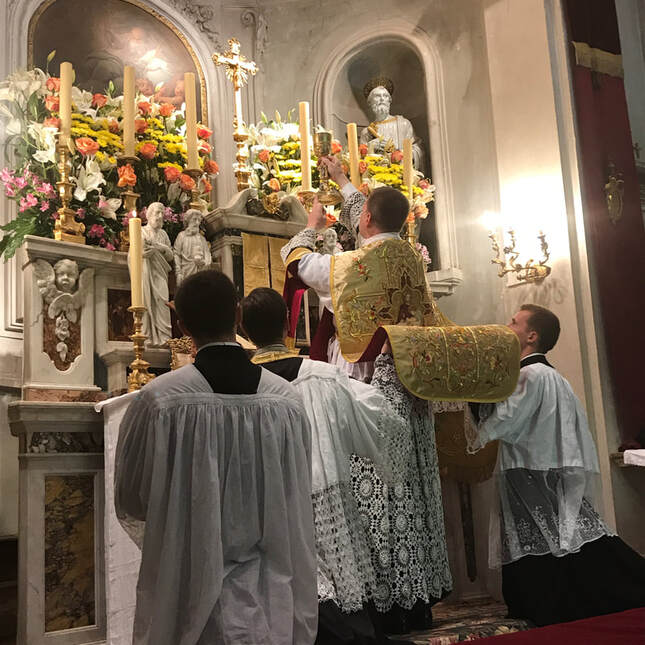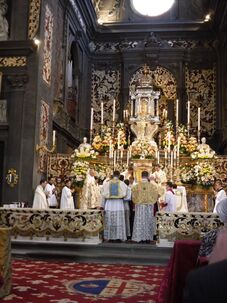what is "bespoke" tailoring?
“Bespoke” refers to custom designed, made to order garments (in contrast to “off the rack” mass produced garments). From the old English (1580s and later), the term comes from “bespeak” – to discuss, to arrange, to order. To provide this customization, tailors would carry textiles in their shops to offer their clients. Once selected, the fabric was “spoken for” and a one-of-a-kind order ensued.
|
|
“Thou shalt put on them the holy vestments, that they may minister to me,
and that the unction of them may prosper to an everlasting priesthood.”
– Exodus 40:13
Practical considerations For initiating a custom order:
|
- Number of pieces: Low Mass (5), High Mass (7), Solemn High Mass (12), Pontifical High Mass (19) and additional pieces which vary by the priestly order. Please provide the pieces you will require at the start of our discussions.
- Rite: Which rite(s) will the set be used for primarily? Positioning of embroideries and number of pieces in the set are often affected by this important consideration. - Color: The symbolism of the liturgical colors is incredibly beautiful and will, in itself, recommend themes to build from for the purpose of uplifting and edifying the faithful in each season. - Devotions/ Symbolism: The Church’s rich treasury of saints and Christian symbols is so vast that it can be difficult to choose or to edit down from so many options. - Personal Sets: An Ordination set is deeply personal and should reflect your devotions. If difficult to decide, a Marian set is *always* a brilliant plan. She is the Queen of Confessors and Mother of All – what could be better for a First Mass of Thanksgiving?! - Parish Sets: A Parish set should be made to fit a variety of priests since the set will belong to the community and become a part of the parish treasures. Great care should be made when designing parish vestments such that the cuts chosen will be easily enjoyed by successors. For example, a conical chasuble would be least likely to be chosen. If you are blessed with an older church of great beauty, consider leveraging its’ architectural language. The result can be a set that looks like it was made at the time the church was built – a time-capsule from the sacristy. |
- Chasuble styles: Click on the “Chasuble Styles” menu for descriptions and examples.
- Adding pieces at a later date: This is not advisable. Dye lot variations and discontinued fabrics make this risky. If budget is a factor, it is better to reduce the ornamentation of the overall set in order to afford making all the pieces up front. You will likely never look back and will be happiest with a full set. - Budget: Please have a realistic idea of what you want to target for a budget in order to steer the conversation in the right direction from the start. Unless the vestment design has been made before, we will need time to price and source materials that are appropriate for your vision. We can work together to scale the project accordingly. - Gifting to a priest: It is best to let the wearer collaborate on the vestment commission. Otherwise, it is highly likely to be altered or never worn. Priests are very particular about vestiture and know what they do and don’t like and what works for them in the movements of the mass at the altar. - Benefactors: You would be surprised how many parishioners, family and friends would love to have something made for a new priest or their current pastor. It’s also surprising how one person taking up an informal collection can make this vision a reality. - Patrons: The Church has long depended on the generous hearts of patrons of the sacred arts to help carry forth the critical work of “evangelization through beauty”. This is indeed the work of our time. The Church desperately needs her beauty repaired, restored and made new again. |
MEASUREMENT FORMS
Priests are welcome to download the files below that will help with measurements and design.
BORROMEO
| altarworthy_client_measurement_borromeo.pdf |
NERI
| altarworthy_client_measurement_neri.pdf |
More coming...




